Bird Feeders
Where to place a bird feeder - please read first
You might well be thinking that you should not place your bird feeder next to window because the birds will be too scared to use the feeders. What do you do instead? Most likely, you will place the feeder a few metres away from the window so that they are still close enough to enjoy watching from the comfort of your home. Unfortunately, the birds will look into your window and see the reflection. Thinking there is another bird feeder, they will fly directly at the window. By the time they strike the glass, they will have reached a velocity that will cause a fatal impact.
If you want to see the birds up close and not cause injury, then place the feeders within 2 feet of the glass. If they do fly into the window, they will not hit the glass hard enough to seriously hurt themselves. Rest assured; the birds will overcome any fear if the food is regularly available. Otherwise, place feeders a lot further away in positions where birds cannot see a reflection and use a pair of binoculars.
Choosing a bird feeder
You have to make some choices in order to get the appropriate bird feeder.
1) Does the feeder need to be squirrel proof?
2) What type of birds are on the top of your list to attract in your area? This would be determined by the type of bird food that you put out.
3) What is your price range or do you intend to make your own?
4) Is the feeder easy to clean?
5) is the feeder easy to fill in the snow and in the cold?
If you have squirrels, the feeders at the very least have to be squirrel trash-proof. In other words, they have to be designed in a way that does not allow squirrels to rip the top off and simply munch their way through all the seed in storage. Plastic and wooden feeders may be gnawed down until they are broken if there is a weak spot in the design. I had a suet plug feeder that was made of 4 inch solid wood. It was chewed through in less than 2 days.
Bird feeders can become the means by which diseases are easily transferred between birds. If you want to have fun with feeding birds, then you must do your bit by regularly cleaning a feeder. The seeds that are exposed to rain can become a mouldy cake that sticks to the bottom of the feeder so you need to be able to easily take apart the feeder. A feeder that requires a tool kit for this purpose is less desirable. When there is an outbreak of avian flu or some other avian virus, you should consider not putting out any bird food for a while.
Platform feeders
| |
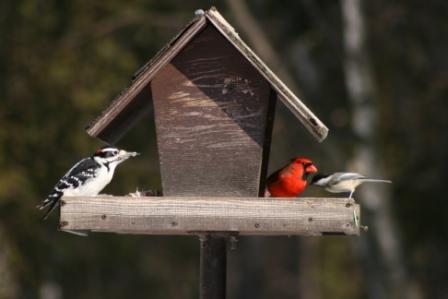 |
|
| |
Platform feeders support a wide range of birds. |
|
These type of feeders are great for visibility and are easily found by birds. They are also accessible to the widest range of birds and are easy to refill. Some birds prefer a low platform (called a ground feeder) while most prefer a raised platform. The drawbacks of these feeders are that the food does not last long; they attract non-native birds; they attract birds that kill songbirds (such as Jays, Crows, House Sparrows and Cowbirds); there is little protection from the elements and therefore food has to be replaced on a regular basis; and the feeders may be hogged by bird bullies such as Blue Jays and Starlings or by squirrels. As you can probably tell, I am not particularly a fan of these types of feeders. It is possible to get squirrel-proof platform feeders, but they are expensive and have a limited holding capacity. Hopper feeders are like platform feeders except they have a much larger holding capacity and the stored seeds are protected from the elements. Some hopper feeders are squirrel proof and can be adjusted to exclude large birds as well.
Instead, try a more specialised feeder that attracts a narrower range of birds without the issues mentioned above.
| |
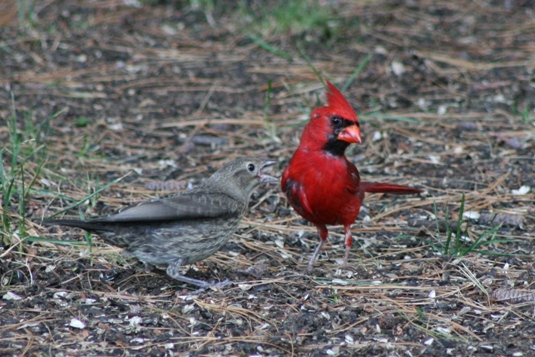 |
|
| |
Cowbirds lay eggs in other birds' nests, especially those of Cardinals. The cowbird hatches first, grows faster and demands more food leading to the death of the other chicks. Cowbirds have done very well due to human disturbance and are a factor in the reduction of songbird populations. |
|
Peanut tube feeders
Vertical peanut feeders are great for attracting a variety of birds. My feeder is visited by Red and White Breasted Nuthatches, Black-Capped Chickadees and Woodpeckers. The advantage of these type of feeders is that they are more attractive to birds that are good at clinging. This automatically discourages a lot of unwanted birds such as House Sparrows and Starlings. Make sure you get a feeder like this one that does not have a platform attached or a space on the top to feed. These feeders are not squirrel proof but they are squirrel trash-proof. I have seen Blue Jays on these feeders, but while Blue Jays love peanuts, they are not particularly good at clinging and will not hog the feeder.
| |
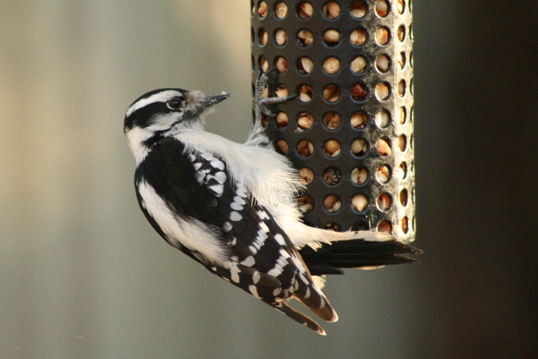 |
|
| |
Woodpeckers love peanuts in vertical feeders. |
|
| |
 |
|
| |
You may have noticed that this Red Breasted Nutchatch uses only one claw to hold onto the feeder. Nuthatches are easy to identify because they like to hop down trees and feeders. |
|
| |
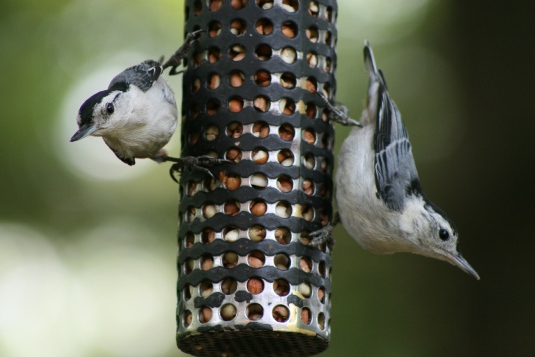 |
|
| |
White-breasted nuthatches en famille |
|
Now birds are not the only animals that love peanuts and if you put your feeder on a squirrel proof pole, there is still one small mammal that will take advantage when perhaps you are not looking.
| |
 |
|
| |
Northern Flying Squirrel |
|
Flying squirrels are still common in many parts of North America where there is high proportion of coniferous trees. They eat insects and fungi, but they will readily eat peanuts too.
Suet and nut bar feeders
Suet feeders attract the same sort of birds as vertical peanut feeders. They are typically used in winter because suet goes rancid quickly in summer and may actually melt. Squirrels will also take advantage of them so provide alternative food sources for these animals in the hope that they may not hog the suet feeder. The basic suet feeders sold in box stores are typically a wire cage with one side that clips on. I would not recommend these because squirrels soon learn to rip the side off and demolish the whole suet block. You can use the attached chain to help keep side panel locked on but in cold weather, it is preferable to have something that can be refilled quickly and easily.
| |
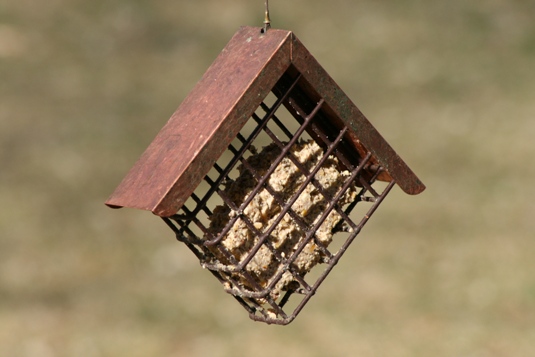 |
|
| |
The above suet feeder has remained squirrel trash-proof through a full winter in my garden. The lid lifts off easily, but it is awkward for the squirrels to hold up the lid while they get at the suet. |
|
Single suet feeders are great for small woodpeckers, but if you really want to bring in the woodies, you need to upgrade to a double-sized suet feeder with a tail prop. Woodpeckers use their tails to help them cling and the feeder shown below has an extension for this purpose.
| |
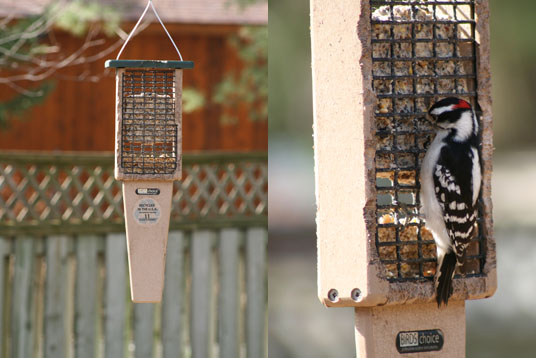 |
|
| |
Unfortunately, this particular feeder was not squirrel trash-proof. The picture on the right shows the damage done in under a few weeks by squirrels. They chewed through the plastic that holds the metal grate in place. This feeder would not make it through a winter in my garden. |
|
| |
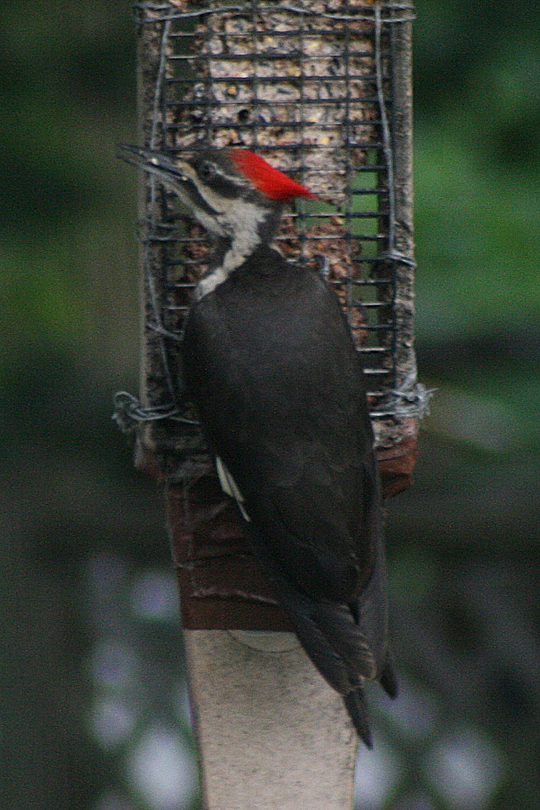 |
|
| |
Pileated woodpeckers will come to double suet feeders. Since they can have large territories up to 1000 acres, you may only see them for a couple of weeks each year. This feeder was protected by the best dome on the market; however, it has still been attacked by squirrels, which explains the wire used to hold the mesh together. |
|
You will find the odd starling feeding at a suet feeder, especially during the breeding season. If this bothers you, then you might want to try an upside-down feeder. They can hold either nut bars, which is a premium food, or suet. They are not squirrel proof, so you will need to be able to place them in a suitable location. The feeder will attract woodpeckers and nuthatches although it may take a few days for them to get used to the feeder. These feeders are easier to fill than regular suet feeders due to the open flap on top.
| |
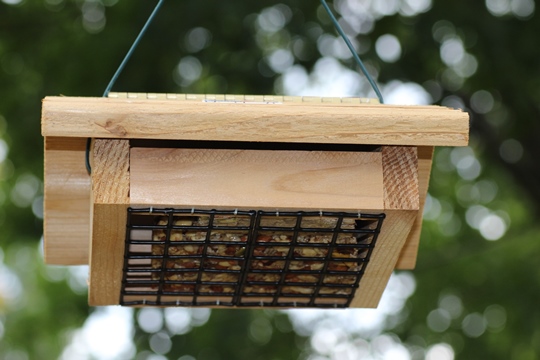 |
|
| |
An upside-down feeder. |
|
General tube feeders
General tube feeders support a wide variety of birds and mammals (if allowed). If you can have only one feeder in your garden, then I would recommend buying one of these. Some tube feeders also have different compartments to allow you to offer more than one food type. One of the most important features of a bird feeder is the ease with which they can be cleaned. If you have to get out a tool kit to take apart and clean your feeder, then you are probably not going to clean the feeder at all and it could become a source of disease. To attract a diversity of birds, you have to use a food type that is also attractive to squirrels. Again, if that is going to be a problem then it is worth the extra expense to buy a squirrel-proof feeder. It is also advantageous to buy a feeder with a ring to support the birds rather than pegs because several birds prefer to face the food directly when feeding. I use a feeder from Brome called the squirrel buster plus. Tools are not required for disassembly and the parts can be washed in a dish washer. It has a spring which can be adjusted for tension to keep out squirrels and heavier birds.
| |
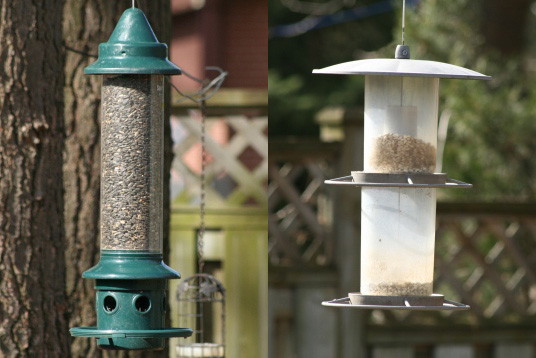 |
|
| |
Brome Squirrel Buster Plus - This expensive feeder will save you money by only feeding the birds and not the squirrels. |
A compartmental feeder with seed that squirrels do not particularly like. The button to release the lid was chewed down by squirrels immediately but the feeder still remained functional for a few years until the squirrels chewed through the hanging wire. |
|
Oriole feeders
| |
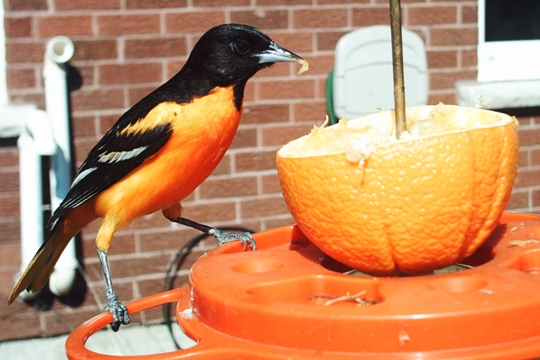 |
|
| |
Oriole feeders are designed for a narrow range of birds. They are a great way to see these birds close-up. The feeder can also be used to feed fruit to birds. |
|
If you are wondering whether it is worth the effort to attract just one species of bird, you will be so glad you went the extra mile every time they turn up to eat. Baltimore Orioles are stunning birds. You do not need an oriole feeder per se to attract orioles, but good ones provide three different types of food for them. They function in a similar fashion to hummingbird feeders in that they have a well for sugar solution and holes for access. The holes in hummingbird feeders are probably too small to be used as a substitute. Oriole feeders also contain depressions in the lid for things like grape jelly and oranges can be spiked using the hanging rod (see picture beneath). Just hanging up the orange alone will attract orioles. When the Orioles stop coming, I use the feeder to provide fruit to butterflies or to other fruit eating birds.
| |
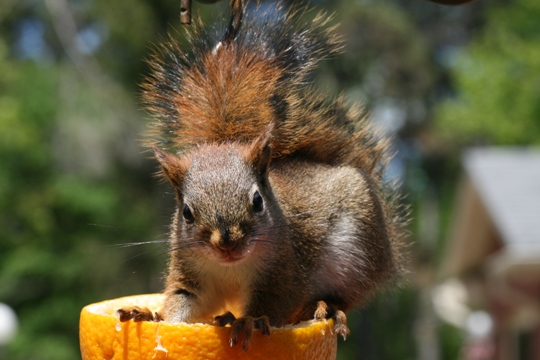 |
|
| |
Apparently, red squirrels are partial to oranges too. |
|
Keeping the squirrels at bay.
Some people like feeding squirrels. I certainly do and it is worth noting that they are a good source of food for birds of prey and for foxes. However, it is preferable to avoid feeding them on a regular basis since they compete directly with songbirds for cavities and they may eat birds' eggs. Squirrels will hog your feeders and consume a vast amount of food (much of which is buried and therefore wasted). There is no cheap way to deter squirrels. However, there is no correlation between the amount you spend and the effectiveness of the deterrent. Shop around and check reviews online before investing your money in these items.
| |
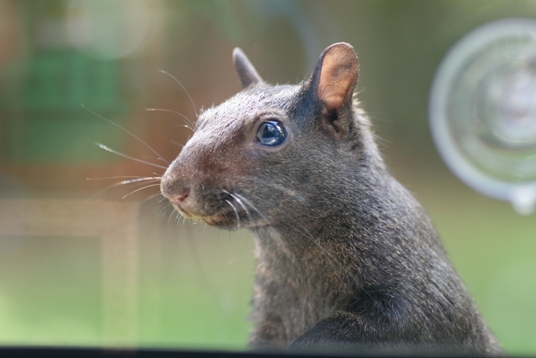 |
|
| |
Squirrels are pretty smart creatures as well as determined when it comes to finding food. They will chew through plastic, wood and sometimes even metal to get a meal. Their antics are quite funny and a window feeder will bring them right up to the glass. |
|
1) Buy squirrel proof feeders. Of course, just because a manufacturer claims they are squirrel-proof does not guarantee that they really are because the squirrels may outwit the device. Generally, these feeders are more expensive, but they will save money in the long run. You have to be careful to follow the guidelines about where to place them. Many feeders are claimed by manufacturers to be squirrel proof when in reality they only stop black/grey squirrels.
| |
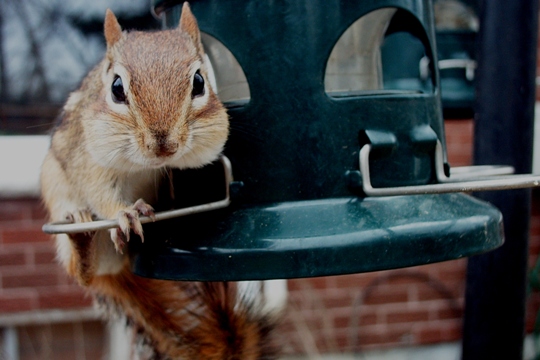 |
|
| |
Squirrel proof feeders are not chipmunk proof and these animals stuff their cheeks full of food. They even eat safflower seed. Positioning feeders higher off the ground may put them off, |
|
a) If the feeder is protected by its own built-in dome, they you must place the feeder at least six feet away from a tree, or some other launching pad to prevent the squirrels from jumping straight onto the feeding platform.
b) If the feeder uses a spring mechanism, they can be placed to within 12 inches of a tree or pole. You need some clearance to prevent the squirrel from supporting its weight on a pole while reaching out to the feeder to grab the food. If you have raccoons, then the distance must be at least 16 inches.
c) If the feeder uses a cage mechanism, then you can place them anywhere. The disadvantage of these feeders is that the birds are less likely to use them and they can get trapped in the cage by a hawk with no escape route.
d) Some feeders use an electric mechanism to deter squirrels and this can be fun to watch. The maintenance of batteries represents an extra hassle that you may not want nor need.
| |
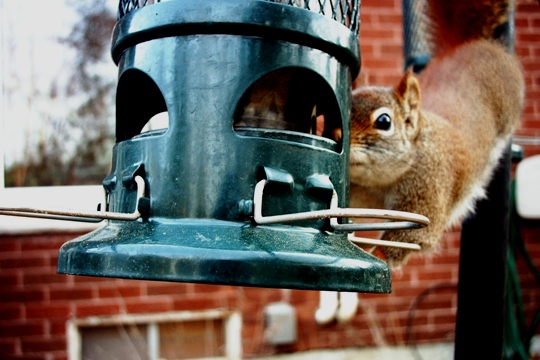 |
|
| |
Squirrels have developed a new yoga pose called the pole stance. Like most other yoga poses, it does not look particularly comfortable, but if it gets you a free lunch..... |
|
2) If your feeder is hanging from a wire, you can buy a dome that is placed between the wire and the feeder. Make sure that you buy a dome close to 18 inches in diameter and which does not flip-flop. A dome that flip-flops will allow squirrels to use their weight to slide right onto the feeder. I have never found a dome that was totally squirrel proof. There always seem to be individuals that are large enough and clever enough to flip themselves over the edge. However, a good dome will definitely make it a lot more difficult.
3) If your feeder is hanging from a pole, you can buy a baffle which is usually a large hollow cylinder. The squirrels have trouble getting a grip on the cylinder and its shape makes it difficult to jump around. The baffle has to be placed at a minimum height of about 3-4 feet so the squirrel is not able to jump over the baffle and up the pole. Make sure you get a baffle that is easy to attach and does not slide down the pole over time. The baffles that work well are often part of expensive pole systems. If you planning on providing various bird foods, a pole system can save you money because the bird feeders themselves do not have to be squirrel proof and are therefore much cheaper to buy. I have been using the squirrel-stopper pole by Liberty products. It successfully prevents grey squirrels, red squirrels and chipmunks from getting food. It costs over $300 so it is not worth buying this for one feeder. One thing to consider that is squirrel-proof bird feeders are very expensive, more complicated, more likely to break and hard to clean.
Avoid feeding starlings
There are some benefits to having starlings in that they help keep some insect populations down. On the other hand, starlings seem to do well around human habitation and they do compete for time at bird feeders and for nesting sites. Starlings have been introduced to many areas of the world and they are definitely not native to North America. Regardless of the lack of evidence that starlings are affecting bird populations, I would prefer to find bird feeding strategies that do not encourage these birds into my garden and instead focus on helping native species. The starlings will get by perfectly well without our help.
Starlings are not great clingers, but they certainly like suet and can get a foothold on thick metal grids that tend to be used on suet feeders. They have a harder time on holed peanut feeders but they can still get food from those feeders as well. If you have a starling problem, then your best bet is to change to other food types. Starlings do not like black sunflower seeds or safflower seeds. If you like attracting woodpeckers, then there are plenty of vertical feeders that will accommodate these two seeds. Black sunflower seeds are a better choice as they feed a wide range of native birds.



